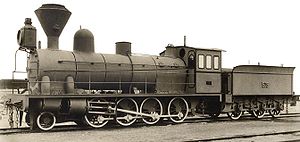Russian series Р
| Russian series Р (R) | |
|---|---|
|
Steam locomotive R
|
|
| Number: | 477 |
| Manufacturer: |
Brjansk Putilow Grafenstaden Sormowo Kolomna |
| Year of construction (s): | 1899-1903, 1905-1911 |
| Retirement: | circa 1940 |
| Axis formula : | 1'D n4v |
| Gauge : | 1524 mm |
| Length: | 10,450 mm |
| Empty mass: | 55.5 t |
| Service mass: | 61 t |
| Friction mass: | 54 t |
| Wheel set mass : | 13.25 t |
| Top speed: | 50 km / h |
| Indexed performance : | 680 hp |
| Starting tractive effort: | 93 kN |
| Driving wheel diameter: | 1,230 mm |
| Impeller diameter front: | 750 mm |
| Number of cylinders: | 4th |
| HD cylinder diameter: | 400 mm |
| LP cylinder diameter: | 600 mm |
| Piston stroke: | 600 mm |
| Boiler overpressure: | 12 bar |
| Grate area: | 2.54 m² |
| Evaporation heating surface: | 155.6-166.9 m² |
| Particularities: | Four-cylinder compound engine in tandem design |
The steam locomotives of the Russian series Р [ ɛr ] were a series of Russian freight locomotives . They had a four-cylinder compound engine in tandem design . Two cylinders were arranged as high pressure and low pressure cylinders on each side. The mode of operation was economical like all compound engines and avoided the expensive bolster axle , but it was unfavorable to repair.
history
Between 1897 and 1904 the Moscow-Windau-Rybinsk Railway built around 2,200 km of railway lines. These were the Bologoye - Pskov , Moscow - Windau and Novosokolniki - Vitebsk routes . On various sections of the route, the existing D-wheel arrangement locomotives were no longer sufficient to achieve the required speeds. As a result, the Р series was designed as a 1'D tandem four-cylinder compound locomotive with internal Allan controls and a leading Bissel axle .
In addition to the Moscow-Windau-Rybinsk Railway, the Moscow-Kiev-Voronezh Railway , the Ryazan-Ural Railway and the South-West Railway also bought locomotives of the Р series.
The pistons of both cylinders on each side sat on a common piston rod, the steam coming from the high-pressure cylinder on the right-hand side flowed through an overflow pipe into the low-pressure cylinder on the left-hand side, and vice versa, the steam coming from the high-pressure cylinder on the left-hand side flowed into the low-pressure cylinder on the right-hand side.
The design of the steam locomotive took into account its use as a snow plow . In terms of tractive power, the locomotive could not compete with the Щ series , which had a 21% higher friction mass.
The steam locomotive was designed by engineer Ludwig Mawrikiev Levi . 477 locomotives were manufactured from the series. 20 of these locomotives were produced by the Alsatian engineering company Grafenstaden .
The locomotives proved their worth in the lowlands, but they were unsuitable for mountain lines such as the Ryazan-Ural Railway and the Kozlov - Voronezh - Rostov line of the South-West Railway . In 1914 the locomotives of the Ryazan-Ural Railway were handed over to the Moscow-Brest Railway. From 1925 to 1930 the locomotives were used in freight traffic on the Moscow - Gorky route (Moscow-Kursk Railway). Around 1940, the Р series locomotives were replaced by more powerful types in train service and were only used on industrial sidings.
See also
literature
- Vitaly Alexandrowitsch Rakow: Russian and Soviet steam locomotives . 1st edition. transpress, Berlin 1986, ISBN 3-344-00060-8 , pp. 97-99 .
Individual evidence
- ↑ Брянский машиностроительный завод. История 1873-1914
- ↑ Website about the Р series (Russian), accessed on March 10, 2019
